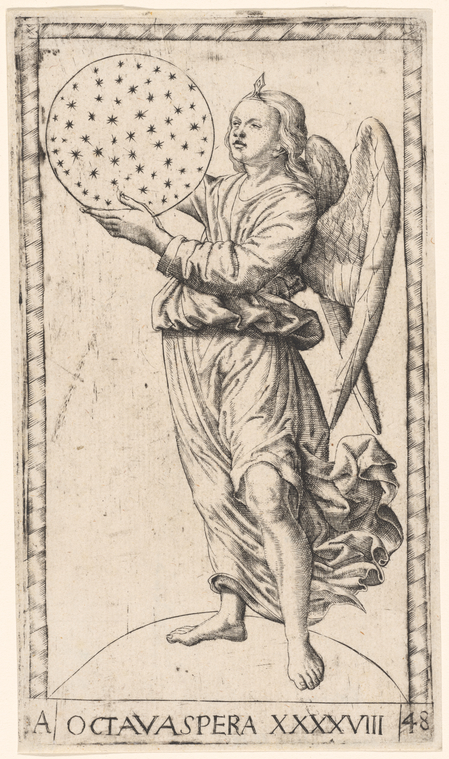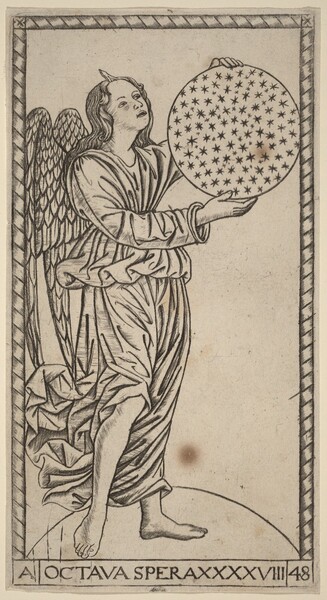SCHEMATIZING (28)
By:
February 22, 2024
One in a series of posts via which HILOBROW’S Josh Glenn will attempt to depict the intellectual and emotional highs and lows of developing a semiotic schema.

This deck of cards was a teaching aid depicting the Renaissance-era cosmos. This particular card is part of a sub-series of 10, which includes the seven Spheres of the Sun, Moon and five traditional planets (Mercury, Venus, Mars, Jupiter and Saturn), plus the eighth sphere (Octava Spera) of the fixed stars, the Primum Mobile, and Prima Causa (First Cause, God, the Unmoved Mover).
The celestial spheres, or celestial orbs, were the fundamental entities of the cosmological models developed by Plato, Eudoxus, Aristotle, Ptolemy, Copernicus, and others. In these celestial models, the apparent motions of the fixed stars and planets are accounted for by treating them as embedded in rotating spheres made of an aetherial, transparent fifth element (quintessence), like gems set in orbs. Since it was believed that the fixed stars did not change their positions relative to one another, it was argued that they must be on the surface of a single starry sphere.
The constructor of a semiosphere faces an ancient problem: How to account for the fact that some aspects of this “universe” remain in relatively fixed positions, while other aspects are in motion?
I feel that aether / quintessence could be a useful concept for semiotic schema-constructors. What is the medium that holds all these disparate elements apart-yet-together, and which allows for a certain (limited) amount of movement and change?
In the fourth century BC Plato’s Timaeus proposed that the body of the cosmos was made in the most perfect and uniform shape, that of a sphere containing the fixed stars. It posited that the planets were spherical bodies set in rotating bands or rings.
From about 1250 until the 17th century, virtually all educated Europeans were familiar with the Ptolemaic model of nesting spheres and the cosmic dimensions derived from it. In the early 1600s, Kepler continued to discuss celestial spheres, although he did not consider that the planets were carried by the spheres but held that they moved in elliptical paths described by Kepler’s laws of planetary motion.
Kepler’s Platonic cosmology filled the large gaps with the five Platonic polyhedra, which accounted for the spheres’ measured astronomical distance. In Kepler’s mature celestial physics, the spheres were regarded as the purely geometric spatial regions containing each planetary orbit rather than as the rotating physical orbs of the earlier Aristotelian celestial physics.
In the late 1600s, Greek and medieval theories concerning the motion of terrestrial and celestial objects were replaced by Newton’s law of universal gravitation and Newtonian mechanics.
Below: An Octava Spera from c. 1470.
MORE FURSHLUGGINER THEORIES BY JOSH GLENN: SCHEMATIZING | IN CAHOOTS | JOSH’S MIDJOURNEY | POPSZTÁR SAMIZDAT | VIRUS VIGILANTE | TAKING THE MICKEY | WE ARE IRON MAN | AND WE LIVED BENEATH THE WAVES | IS IT A CHAMBER POT? | I’D LIKE TO FORCE THE WORLD TO SING | THE ARGONAUT FOLLY | THE PERFECT FLANEUR | THE TWENTIETH DAY OF JANUARY | THE REAL THING | THE YHWH VIRUS | THE SWEETEST HANGOVER | THE ORIGINAL STOOGE | BACK TO UTOPIA | FAKE AUTHENTICITY | CAMP, KITSCH & CHEESE | THE UNCLE HYPOTHESIS | MEET THE SEMIONAUTS | THE ABDUCTIVE METHOD | ORIGIN OF THE POGO | THE BLACK IRON PRISON | BLUE KRISHMA | BIG MAL LIVES | SCHMOOZITSU | YOU DOWN WITH VCP? | CALVIN PEEING MEME | DANIEL CLOWES: AGAINST GROOVY | DEBATING IN A VACUUM | PLUPERFECT PDA | SHOCKING BLOCKING.

